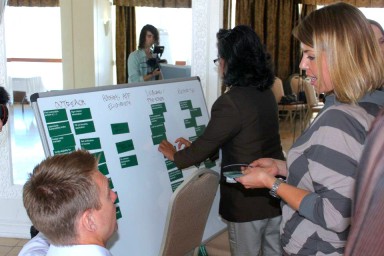Ending homelessness is about breaking down barriers. Nothing should stand in the way of providing our neighbors experiencing homelessness with the dignity and necessity of a home. Through Zero: 2016, we’re committed to working with communities to break down any barriers that may stand in the way of meeting our goal and ending veteran and chronic homelessness in the next two years.
Among the most imposing of these barriers is the often disorganized and inefficient process that an individual or family experiencing homelessness must navigate in order to access stable housing in their community. Fraught with roadblocks and the often challenging task of coordinating across multiple agencies and non-profit groups, local housing placement processes can often take more than a year to lead to a home– a year that many people experiencing homelessness simply can’t spare.
Fraught with roadblocks and the often challenging task of coordinating across multiple agencies and non-profit groups, local housing placement processes can often take more than a year to lead to a home– a year that many people experiencing homelessness simply can’t spare.
The process of connecting available housing to people in need doesn’t have to be so complicated. It remains so in most communities due to a series of design flaws. Traditionally, those that are the first seek out help are the first to receive it, leaving the most vulnerable, who are often least able to navigate the bureaucratic housing placement process, either unidentified or stuck at the back of the line. Once in line, these people are forced to navigate a patchwork of agencies, each with its own separate systems and protocols, that even trained social workers often struggle to understand. To make matters worse, there is no guarantee that an individual who successfully navigates his or her local housing bureaucracy will be matched to the right kind of housing assistance for their needs at the end of the day– a disabled or mentally ill individual may end up in housing without appropriate social services, for example, or someone whose needs are fairly marginal may be connected to housing with intensive, built-in services that might be better suited for someone else.
To address this problem, we are focused on helping the 71 communities participating in Zero: 2016 to design and improve their local housing placement systems. These communities are committed to creating systems that are built for zero, meaning systems that are coordinated, data driven, and optimized to end and maintain an end to veteran and chronic homelessness.
These communities are reimagining their existing systems as Coordinated Assessment and Housing Placement (CAHP) Systems. A CAHP system removes unnecessary barriers and streamlines the housing process by identifying the names and needs of individuals experiencing homelessness and matching them with the best housing options for their circumstances.
Much like an emergency room, a CAHP system can help community leaders thoughtfully triage individuals based on their housing needs in accordance with research and local priorities. Just as an emergency room doctor wouldn’t prescribe the same treatment to all patients, a well functioning CAHP system doesn’t match everyone to the same housing services. Instead, the system draws on available research to match individuals with the housing options that are the most likely to end their homelessness at the lowest cost, ensuring that limited local housing resources can end homelessness for as many people as possible. This data-driven process functions in real time to expedite housing placements and increase coordination and communication among all partners working to end homelessness in a community.
A CAHP system also provides a community with a big-picture, by-name snapshot of everyone experiencing homelessness on its streets and in its shelters, helping community leaders make better decisions about strategy, advocacy and ways to allocate housing dollars.
There is no step-by-step guidebook or mandatory approach to implementing a well functioning CAHP System; in fact, the best systems are flexible enough to incorporate new ideas and efficiency improvements that a community may discover along the way. However, there are a number of concepts and processes that have proven fundamental, especially in leading efforts like the ones pioneered by Home for Good in Los Angeles and a variety of organizations working together in Nashville, TN:
All CAHP systems can be divided into four key areas:
- Assessment
- Navigation and Case Conferencing
- Housing Referral with Choice
- Data Collection and Communication
Later this week, we’ll be exploring these phases and components in more detail and highlighting how each of them fits into the overall strategy of Zero: 2016. Be sure to check back soon for more on assessment, data collection and the critical role that by-name registries play in ending homelessness.
A Housing System Built for Zero Series:




